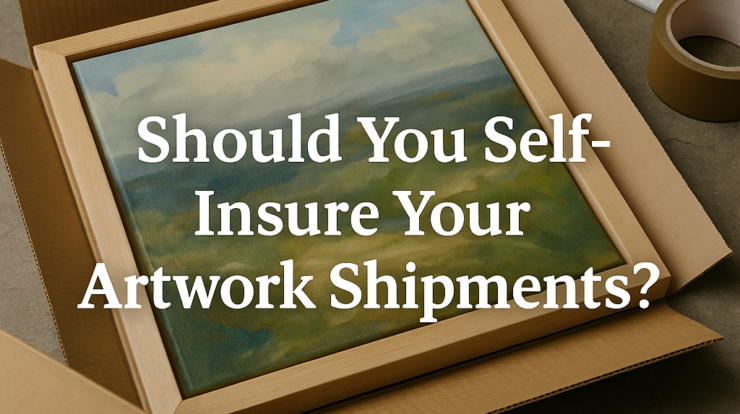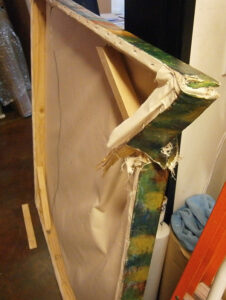
Shipping art comes with risk. Even when you’ve packed everything perfectly, handed it over to a trusted carrier, and crossed your fingers, there’s still that lingering question: What if something goes wrong?
That’s where insurance comes in—or doesn’t.
If you’ve been shipping your work for any length of time, you’ve likely wrestled with whether it’s worth insuring every piece, especially when premiums start adding up. So let’s unpack the real-world pros and cons of self-insuring vs. purchasing coverage, and how to make the right call for your art business.
What Does It Mean to Self-Insure?
Self-insuring simply means you’re choosing to absorb the financial risk of loss or damage yourself, rather than paying a carrier or third-party to do it for you.
You’re betting that the majority of your shipments will arrive safely—and that when something does go wrong, you’ll still come out ahead compared to what you would’ve paid in cumulative insurance fees.
This approach isn’t for everyone, but it can make sense for artists who:
-
Have good packing protocols
-
Ship frequently and want to control costs
-
Understand the risks and are comfortable taking them
What Are the Limits of Carrier Insurance?
FedEx and UPS both offer declared value coverage, but it’s not the same as actual “insurance,” and the limits can be restrictive.
-
UPS typically allows declared values up to $50,000 for most shipments (though the terms and exclusions are worth reading closely).
-
FedEx has a lower ceiling for fine art—often capping liability around $1,000 unless you’ve made special arrangements or used specific services.
-
Neither will cover you for full value if they determine the packaging was insufficient—even if you did your best.
That means high-value work—especially anything over $10,000—is likely underprotected by default. And the finer the work, the higher the stakes.
Third-Party Insurance: Added Protection at a Cost
If you want broader coverage, there are third-party insurers who specialize in fine art shipping. Companies like Shipsurance, Parcel Pro, or your own commercial insurer can offer policies that fill in the gaps.
The upside:
-
Higher value limits
-
Better art-specific protection
-
Often covers things UPS/FedEx won’t
The downside:
-
Added paperwork
-
Cost can range from 1–2% of the artwork’s declared value per shipment
-
Some claims processes are slower or more complicated than you might expect
The Math: When Is Insurance Worth It?
Let’s say you ship 30 pieces a year, each valued around $3,000. If you pay 2% to insure each shipment, that’s $1,800/year in insurance premiums.
Now ask: how often do shipments actually get damaged or lost?
If you’ve been shipping for years and your damage rate is under 1–2%, that $1,800 may be better left in your pocket. Even if you have to eat the cost of a damaged piece every few years, you could still come out ahead.
But if your work is particularly fragile, irreplaceable, or prone to damage—or if your clients would be devastated by delays or loss—it may be wise to pay for peace of mind.

A Balanced Approach
You don’t have to commit to one method for every shipment. Some artists self-insure most of the time, but purchase coverage selectively:
-
For larger or high-value pieces
-
When shipping to new or high-profile clients
-
For works that are non-replicable or time-sensitive
If you’re shipping regularly and want to cover all your bases, another option is to talk to your insurance agent about a business policy that includes shipping coverage. This often ends up being more cost-effective over time.
Final Thoughts
Shipping artwork isn’t cheap—and neither is replacing it. But in most cases, consistent care in packing and a solid understanding of your risk will carry you further than overpaying for protection you rarely use.
Take a look at your shipping history. Run the numbers. And make the call that makes sense for your volume, your artwork, and your peace of mind.
For 40 years of shipping from my gallery, primarily at prices that ranged from $1,000 to $45,000 and averaged $16,000, I had precisely ONE damaged artwork. This was at a rate of probably at least10 works per month. That was at DFW airport when a forklift went through a box into the painting. However, the artist was able to repair the artwork. Thererfore, no damage was ultimated suffered. I have never used UPS because there is just too much handling. They have too many untrained people and it goes through too many places B4 it reaches its destinations. I use Fedex when I want fast, Craters and Freighters when I don’t care about speed. They are reliable and located most places. I have always had my own insurance policy – it’s a jeweler’s policy – with a fairly high deductible, which keeps the premium down. I’ve only had the one claim, which also keeps the premium low. I make shipping and insurance cost a negotiable item, like framing, that is handled at time of sale. Sometimes seller pays, or I pay, or the buyer pays. And when the seller or the buyer pays, then that also lessens my overall cost. But with a policy, I never have to worry about the nickel and dime stuff. I know it’s covered.
Michelle, this is incredibly useful insight—thank you for sharing your decades of experience. Your shipping track record is impressive, and your point about minimizing handling through carrier choice is an important takeaway. The jeweler’s policy approach is a smart angle that many artists and galleries might not think to explore, and treating shipping and insurance as negotiable line items gives you flexibility without compromising on protection. This kind of practical, time-tested strategy is invaluable.
the only pieces i insure are those owned by others and irreplaceable historical works that are in for restoration. anything of my own i can repaint or repair as required. in 40 years of historical restorations had 1 incident where the security guards assigned to shipment were sitting on the crate while the forklift drove the forks right through the work. cost insurance 150,000 for the restoration done by myself so i actually made 150,000 on the deal. i found that if i insure high value works it is like a red flag saying steal me, have searched airports looking for such pieces. the low value anonymous stuff nobody wants. then theres the outright fraud theft beginning with the moment of check in.
Richard, that’s a sobering but important perspective—and one that comes from real, hard-earned experience. Your approach highlights the nuances between insuring personal work versus high-value or third-party pieces, especially in restoration. The caution about high-value labeling drawing the wrong kind of attention is worth serious consideration, particularly for those shipping through busy hubs. It’s a reminder that security isn’t just about packing—it’s about being intentional at every step of the process.
I have Business insurance where my artwork is insured 1) my inventory, 2) in galleries, and 3) in transit. I specify the amount for each category.
When I ship I set the value with the carrier to the minimum $100 to reduce shipping cost. I find the cost skyrocketed if I gave my real value. I’ve never had a shipping claim, but the annual cost for the Maritime Insurance policy is less than the increase shipping cost if I included insurance as part of the shipment.
I have needed to use the policy for damage in a gallery due to a flood, which was well worth the investment in the insurance.